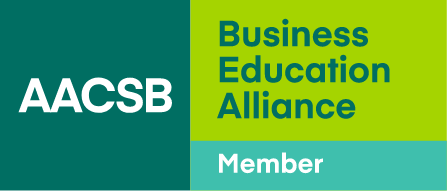Greater Impact Through Faculty Thought Leadership
- Business schools can dramatically expand their societal impact by helping faculty share research insights beyond academia through strategic thought leadership.
- Building faculty visibility in public forums not only strengthens institutional reputation and engagement but also translates scholarly research into real-world change.
- To make thought leadership sustainable, schools should provide structural support—via dedicated teams, external partnerships, and faculty training—to help faculty bridge the gap between research and public relevance.
In recent years, an increasing range of voices has been calling on business schools to pursue research that delivers greater relevance and meaningful societal impact to communities. AACSB itself is foremost among these voices, formally adopting positive societal impact as part of its 2020 accreditation criteria.
The association has gone beyond calling for more socially impactful research, publishing a structured framework full of actionable advice for how schools can go about conducting such scholarship. AACSB also recently formed the Global Societal Impact Task Force, whose objective is to develop a framework “designed to facilitate and motivate evidence-based impact.”
In response to this call, many business schools have been pushing to meet the challenge in various ways. There is, however, an area that is still underused, considering its potential to substantially amplify a school’s impact: the strategic cultivation of faculty thought leadership.
The Missing Ingredient for Impactful Research
Even the most beneficial research does not automatically translate into concrete societal benefits. To influence cultural attitudes, public policy, and organizational practice, research findings need to be disseminated to the broader public, whether they’re related to sustainability initiatives, data privacy legislation, climate change, or any other pressing challenge.
Research that leads to greater public awareness of important issues increases demand for beneficial changes. Without public pressure, policymakers and organizational leaders may be slow to react or resist making any changes at all.
Research that leads to greater public awareness of important issues increases demand for beneficial changes. Without public pressure, policymakers and organizational leaders may resist making any changes at all.
However, not all ways to disseminate research-based information are equally effective at inspiring the kind of public engagement that makes a real difference. One of the most powerful ways to inspire the right kinds of meaningful changes—in the right places—is faculty thought leadership.
Faculty thought leadership occurs when academics share their expertise, research findings, and viewpoints in the general media beyond academic contexts—via means such as interviews, blogs, podcasts, radio and TV appearances, speaking engagements, and social media posts. Faculty can use any and all of these channels to communicate their thought leadership, increasing the visibility of and access to their research and ideas. In the process, they promote both themselves and their business schools.
A Means for Achieving Two Goals
There is growing recognition among business schools, and within higher education as a whole, that effective faculty thought leadership can boost institutional reputation, attract prospective students, and increase the positive societal impact of the school and its research. Currently, however, most data on the effectiveness of thought leadership comes from the corporate world, where the practice has been the norm longer than it has been in higher education.
According to a collaborative study by Edelman and LinkedIn, 75 percent of decision-makers say they have been inspired by a piece of thought leadership content to look into a product or service that they had not been previously considering. Seventy-three percent say that they trust an organization’s thought leadership content more than its traditional marketing materials. And an overwhelming 90 percent say they are more likely to be receptive to marketing outreach from an organization that consistently produces high-quality thought leadership.
Who would those decision-makers be in a higher education context? From an enrollment perspective, they would be prospective students and their families. From a research-impact perspective, they would be potential corporate partners, nonprofit organizations, policymakers, media outlets, and journalists.
Schools that do not tap faculty thought leadership to boost their impact are not just missing an opportunity. They are failing to adapt to an increasingly competitive and shifting academic landscape.
The Need for Structural Support
At the same time, it would not be reasonable to put the onus of cultivating thought leadership on faculty alone. Most academics simply do not have enough time to add yet another responsibility as they juggle teaching, research, advising, committee work, doctoral student supervision, and other duties. Moreover, review, promotion, and tenure processes at many schools incentivize academics to focus more on publishing papers in academic journals than on engaging with the public sphere.
Many business schools turn to internal marketing and public relations teams to share thought leadership more widely. But, like faculty, these teams are already stretched thin with their existing responsibilities. In fact, according to a survey by The Chronicle of Higher Education, faculty, staff, and administrators across academia are experiencing widespread exhaustion and burnout.
Schools that do not tap faculty thought leadership to boost their impact are not just missing an opportunity. They are failing to adapt to an increasingly competitive and shifting academic landscape.
Even so, business schools can’t afford to neglect what is arguably becoming a mandatory strategy for promoting both their research and their institutions as a whole. So, what are the solutions? Generally speaking, schools can adopt one of three broad approaches, depending on their unique circumstances:
Establish a small, internal team. This group can focus exclusively on faculty thought leadership, in collaboration with the school’s marketing team, without other marketing and PR duties competing for their time. Even one or a few existing staff members can have their roles transitioned to this work without the need to hire additional staff, especially if resources are constrained.
Outsource the work to an external higher education PR agency. An agency can do the heavy lifting to build media relationships and create opportunities to share research with the public; faculty merely need to show up to these opportunities, voice their opinions on pertinent issues, and share their research-based insights. Many PR agencies also offer other services—such as op-ed ghostwriting—which can make participation even easier and more enjoyable for faculty.
Adopt a hybrid arrangement. Here, an internal team coordinates with an external agency. For example, a hybrid arrangement might involve an external agency becoming familiar with the faculty’s work and then matching them with thought leadership opportunities via its media relationships. Then, as content gets published on different platforms and formats, the internal team can amplify the content’s reach by promoting it via the school’s website, blog, newsletters, and social media accounts. The internal team might also use faculty’s individual social media accounts, which often go underutilized for the purpose of sharing research findings.
Two More Critical Best Practices
No matter which of these three broad approaches are used, there are two additional, more specific practices that schools should adopt:
Train faculty to engage external audiences. While faculty are experts in their disciplines, many have limited experience translating research into accessible insights for business leaders, policymakers, and the media. Training them in areas such as op-ed writing, media interviews, and effective social media use can help bridge this gap.
At the same time, technology offers practical tools that make this work more manageable. Podcasts, digital newsletters, and platforms such as LinkedIn allow faculty to share their ideas directly, while scheduling and content tools help reduce the time burden.
For example, faculty at my school, the University of San Diego’s Knauss School of Business, already lead important conversations on topics such as ethics; student success; and environmental, social, and governance issues. The school offers resources to help them amplify their voices and ensure that their scholarship influences not only classrooms and journals but also public dialogue. By combining training from the Knauss marketing and media staff with the smart use of technology, we lower barriers, encourage more consistent participation, and extend the reach of faculty expertise well beyond campus walls.
Schools can structure opportunities that not only elevate faculty’s visibility but also ensure that their research remains connected to real-world needs.
Co-host workshops with members of the business community. It’s important for schools to bring practitioners and faculty together in dialogue. At the Knauss School of Business, for instance, faculty participate in workshops as subject-matter experts, contributing research-driven insights while also learning directly from industry perspectives.
Two such signature outreach programs include “Professors with a Purpose” and “Lunch and Learns,” each designed to extend faculty expertise beyond campus. During these programs, faculty share research insights and engage with alumni, prospective and current graduate students, corporate partners, community organizations, and other audiences. The sessions also foster meaningful dialogue around contemporary business and social issues that align with the school’s mission of developing socially responsible leaders with a global mindset.
These touchpoints exemplify how schools can structure opportunities that not only elevate faculty’s visibility but also ensure that their research remains connected to real-world needs.
Business schools are being called on, from both within and without, to adapt and evolve. They are being asked to boost the societal impacts of faculty research, adapt strategically to a rapidly shifting higher education landscape, and enhance their appeal to prospective students and other stakeholders. Faculty thought leadership is so powerful because it advances all three of these objectives.
It’s up to each institution to think through the “how,” but the “what” and the “why” are clear: Faculty thought leadership is no longer just a nice option for business schools to undertake. If schools want their research to lead to true social benefit, it is now a strategic imperative.





